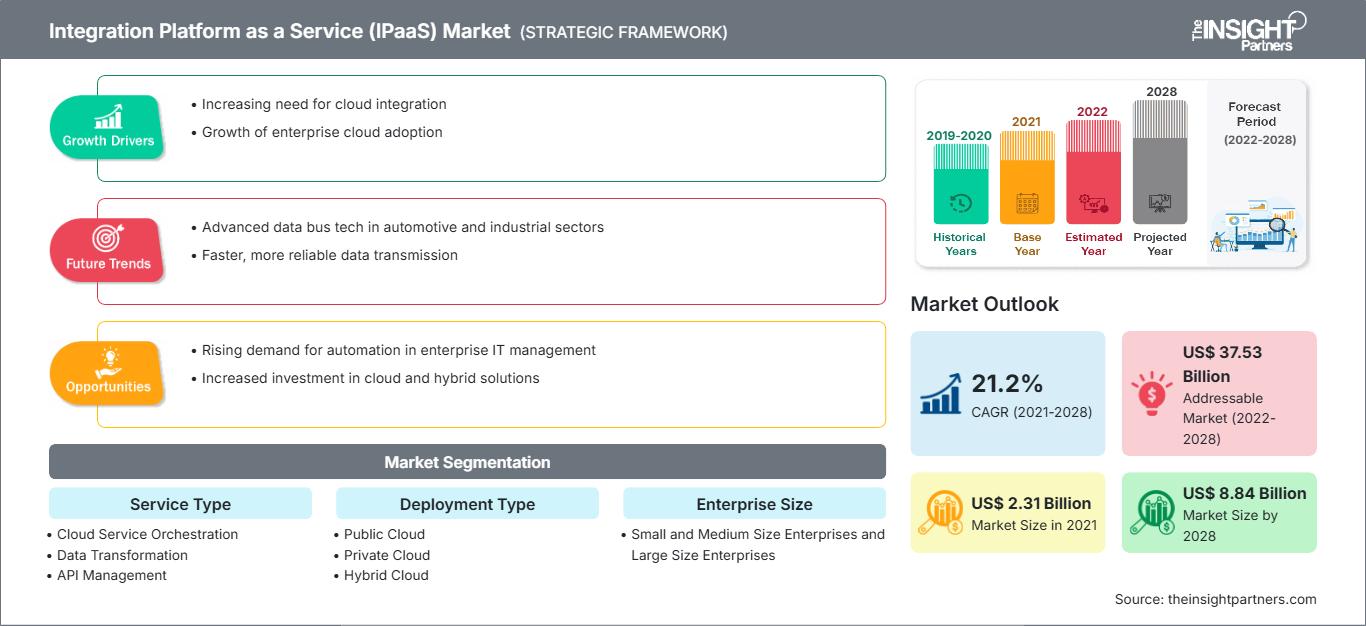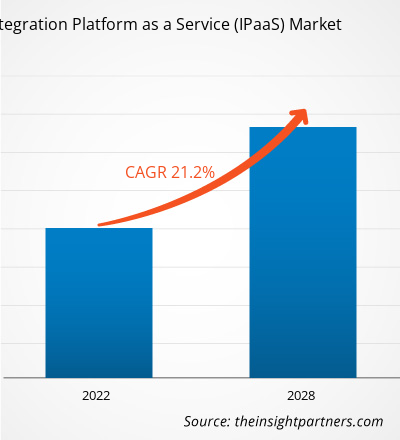Der Markt für Integration Platform as a Service (IPaaS) wurde im Jahr 2021 auf 2.306,32 Millionen US-Dollar geschätzt und soll bis 2028 8.844,20 Millionen US-Dollar erreichen; von 2021 bis 2028 wird ein CAGR-Wachstum von 21,2 % erwartet.
Die zunehmende Bedeutung von Cloud-Echtzeitüberwachung in Unternehmen steigert die Nachfrage nach Integration Platform as a Service. Die Sicherheit und Leistung des Netzwerks kann einen großen Einfluss auf den Gesamterfolg eines Unternehmens haben. Daher muss jedes Unternehmen, insbesondere im E-Commerce-Bereich, seine Netzwerke regelmäßig im Auge behalten, um sicherzustellen, dass alles reibungslos funktioniert. Sie müssen genau wissen, was Echtzeit-Netzwerküberwachung ist und wie ihr Unternehmen davon profitieren kann, um ein klares Bild von der Leistung der Systeme zu erhalten. Die Verwendung von Apps und Tools, die kontinuierlich Momentaufnahmen der Gesamtleistung des Netzwerks verfolgen und aufzeichnen, wird als Echtzeitüberwachung bezeichnet. Unternehmen nutzen Echtzeitüberwachung, um Netzwerkaktivitäten zu verfolgen, die Netzwerksicherheit zu verbessern und mögliche Probleme sofort zu erkennen. Jedes Unternehmen, unabhängig von seiner Größe, kann von Echtzeit-Netzwerküberwachung profitieren.
Darüber hinaus ermöglichen Cloud-Echtzeitüberwachungsdienste Unternehmen, die Reaktionszeit auf Vorfälle zu verkürzen. Für Unternehmen ist es entscheidend, Probleme so schnell wie möglich zu beheben, egal wie geringfügig sie erscheinen. Beispielsweise mag es selbstverständlich erscheinen, schnell auf einen Cyberangriff oder eine Datenpanne zu reagieren, doch selbst scheinbar kleine Probleme wie eine langsam ladende Website oder eine Vielzahl von 404-Fehlern können erhebliche Auswirkungen auf Unternehmen haben. Echtzeit-Netzwerküberwachung kann Unternehmen helfen, diese Ereignisse sofort zu erkennen und schnell zu reagieren. Daher trägt die Einführung von Cloud-Echtzeitüberwachungsdiensten im Laufe der Zeit zum Marktwachstum bei.
Passen Sie diesen Bericht Ihren Anforderungen an
Sie erhalten kostenlos Anpassungen an jedem Bericht, einschließlich Teilen dieses Berichts oder einer Analyse auf Länderebene, eines Excel-Datenpakets sowie tolle Angebote und Rabatte für Start-ups und Universitäten.
Markt für Integration Platform as a Service (IPaaS): Strategische Einblicke

- Holen Sie sich die wichtigsten Markttrends aus diesem Bericht.Dieses KOSTENLOSE Beispiel umfasst Datenanalysen, die von Markttrends bis hin zu Schätzungen und Prognosen reichen.
Auswirkungen der COVID-19-Pandemie auf den Markt für Integration Platform as a Service (IPaaS)
Sie erhalten kostenlos Anpassungen an jedem Bericht, einschließlich Teilen dieses Berichts oder einer Analyse auf Länderebene, eines Excel-Datenpakets sowie tolle Angebote und Rabatte für Start-ups und Universitäten.
Markt für Integration Platform as a Service (IPaaS): Strategische Einblicke

- Holen Sie sich die wichtigsten Markttrends aus diesem Bericht.Dieses KOSTENLOSE Beispiel umfasst Datenanalysen, die von Markttrends bis hin zu Schätzungen und Prognosen reichen.
Der beispiellose Anstieg der COVID-19-Fälle weltweit und der anschließende Lockdown zur Eindämmung der Virusausbreitung in den ersten beiden Quartalen 2020 haben zahlreiche Unternehmen in einen Wartezustand versetzt. Aus den oben genannten Gründen gingen die Technologieinvestitionen 2020 zurück. Die COVID-19-Pandemie hat jedoch die Homeoffice-Szenarien weltweit beschleunigt und Unternehmen dazu veranlasst, Cloud-Server für einen reibungslosen Remote-Geschäftsbetrieb einzusetzen. Ende 2020 verzeichneten globale Unternehmen einen Anstieg der Investitionen in Cloud-Lösungen, um einfaches Remote-Arbeiten zu ermöglichen. Daher wird erwartet, dass die zunehmende Nutzung von Cloud-Lösungen und -Plattformen in allen Unternehmen weltweit die Nachfrage nach Plattformintegrationsdiensten steigern und so zum Marktwachstum im Prognosezeitraum beitragen wird.
Markteinblicke – Wachstum des Marktes für Integration Platform as a Service (IPaaS) bei der Nutzung von Hybrid- und Multi-Cloud-Infrastrukturen
Es wird erwartet, dass in den kommenden Jahren viele Unternehmen Hybrid- und Multi-Cloud-Strategien einführen werden, da diese Systeme in den entsprechenden Branchen im Trend liegen. Unternehmen werden sich voraussichtlich für diese Strategien entscheiden, da sie nicht von einem einzigen Cloud-Anbieter abhängig sein möchten. Laut IBM Corp. planen 98 % der Unternehmen bis 2021 die Nutzung mehrerer Hybrid Clouds. Die Hybrid Cloud bietet die Vorteile von Public und Private Clouds und erhöht die Flexibilität beim Arbeiten zwischen beiden Cloud-Lösungen. Darüber hinaus ermöglicht sie es Unternehmen, ihre vertraulichen Daten durch die Speicherung in der Private Cloud zu schützen und gleichzeitig die Public Cloud zur Speicherung öffentlicher Daten zu nutzen. Die Anforderungen spezifischer Anwendungen und Funktionen werden sich mit der Zunahme spezialisierter Dienste verändern. Dies wiederum ermutigt die Geschäftsmanager, sich für Multi-Cloud- und Hybridlösungen zu entscheiden, um das System effektiv und effizient zu betreiben. Darüber hinaus ist es kostengünstig und mindert das Risiko von Geschäftsverlusten. Die Einführung der Hybrid Cloud wird auch das Marktwachstum für Integration Platform as a Service (IPaaS) beeinflussen. Das Hybridmodell erfordert eine ordnungsgemäße Integration, um einen reibungslosen Geschäftsbetrieb im Laufe der Zeit zu gewährleisten und so zum Marktwachstum beizutragen.
Servicetyp-basierte Erkenntnisse
Basierend auf dem Servicetyp ist der Markt für Integration Platform as a Service (IPaaS) in Cloud-Service-Orchestrierung, Datentransformation, API-Management, Datenintegration, Echtzeitüberwachung und -integration, Business-to-Business- und Cloud-Integration, Bereitstellungstypintegration und andere segmentiert. Das Segment der Cloud-Service-Orchestrierung hatte im Jahr 2020 den größten Marktanteil.
Akteure, die auf dem Markt für Integration Platform as a Service (IPaaS) tätig sind, konzentrieren sich hauptsächlich auf die Entwicklung fortschrittlicher und effizienter Produkte.
- Im April 2021 hatte Informatica eine Cloud-Plattform angekündigt, die Microservices und eine KI-Engine nutzt, um Datenverwaltungsfunktionen zu kombinieren und die Integration von Daten und Anwendungsprogrammierschnittstellen (API) zu ermöglichen.
- Im August 2019 kündigte MuleSoft, Anbieter der führenden Plattform zum Aufbau von Anwendungsnetzwerken, die Verfügbarkeit von MuleSoft Government Cloud an, einer Cloud-Bereitstellungsumgebung, die Integration Platform as a Service (IPaaS) und vollständiges Lebenszyklus-API-Management in einer einzigen Laufzeit kombiniert. Durch die Bereitstellung der Anypoint Platform von MuleSoft in der Government Cloud-Umgebung können Behörden alle ihre Integrationen und APIs von einer einheitlichen, sicheren, Cloud-basierten Plattform aus entwickeln, verwalten und überwachen. Dadurch werden Abläufe vereinfacht und die IT-Agilität erhöht.
Der Markt für Integration Platform as a Service (IPaaS) wurde wie folgt segmentiert: Markt für Integration Platform as a Service (IPaaS) – nach Servicetyp
- Cloud Service Orchestration
- Anwendungsintegration
- API-Management
- Datenintegration
- Business-to-Business- und Cloud-Integration
- Echtzeitüberwachung und -integration
- Datentransformation
- Sonstige
Markt für Integration Platform as a Service (IPaaS) – nach Bereitstellungstyp
- Öffentliche Cloud
- Private Cloud
- Hybrid Cloud
Markt für Integration Platform as a Service (IPaaS) – nach Unternehmensgröße
- KMU
- Großunternehmen
Markt für Integration Platform as a Service (IPaaS) – nach Branche
- IT und Telekommunikation
- BFSI
- Fertigung
- Gesundheitswesen
- Konsumgüter und Einzelhandel
- Energie
- Regierung und öffentlicher Sektor
- Sonstige
Integration Platform as a Service (IPaaS)Regionale Einblicke in den Markt für Integration Platform as a Service (IPaaS)
Die Analysten von The Insight Partners haben die regionalen Trends und Faktoren, die den Markt für Integration Platform as a Service (IPaaS) im Prognosezeitraum beeinflussen, ausführlich erläutert. In diesem Abschnitt werden auch die Marktsegmente und die geografische Lage von Integration Platform as a Service (IPaaS) in Nordamerika, Europa, im asiatisch-pazifischen Raum, im Nahen Osten und Afrika sowie in Süd- und Mittelamerika erläutert.
Umfang des Marktberichts zur Integrationsplattform als Service (IPaaS)
| Berichtsattribut | Einzelheiten |
|---|---|
| Marktgröße in 2021 | US$ 2.31 Billion |
| Marktgröße nach 2028 | US$ 8.84 Billion |
| Globale CAGR (2021 - 2028) | 21.2% |
| Historische Daten | 2019-2020 |
| Prognosezeitraum | 2022-2028 |
| Abgedeckte Segmente |
By Servicetyp
|
| Abgedeckte Regionen und Länder | Nordamerika
|
| Marktführer und wichtige Unternehmensprofile |
|
Dichte der Marktteilnehmer für Integration Platform as a Service (IPaaS): Verständnis ihrer Auswirkungen auf die Geschäftsdynamik
Der Markt für Integration Platform as a Service (IPaaS) wächst rasant. Die steigende Nachfrage der Endnutzer ist auf Faktoren wie veränderte Verbraucherpräferenzen, technologische Fortschritte und ein stärkeres Bewusstsein für die Produktvorteile zurückzuführen. Mit der steigenden Nachfrage erweitern Unternehmen ihr Angebot, entwickeln Innovationen, um den Bedürfnissen der Verbraucher gerecht zu werden, und nutzen neue Trends, was das Marktwachstum weiter ankurbelt.

- Holen Sie sich die Markt für Integration Platform as a Service (IPaaS) Übersicht der wichtigsten Akteure
Nordamerika
- USA
- Kanada
- Mexiko
Europa
- Deutschland
- Frankreich
- Italien
- Großbritannien
- Spanien
- Schweiz
- Restliches Europa
Asien-Pazifik (APAC)
- Australien
- China
- Indien
- Japan
- Südkorea
- Restlicher APAC
Naher Osten und Afrika (MEA)
- Saudi-Arabien
- VAE
- Südafrika
- Rest von MEA
Südamerika (SAM)
- Brasilien
- Argentinien
- Rest von SAM
Integration Platform as a Service (IPaaS) Markt – Unternehmensprofile
- Informatica
- elastic.io
- Software AG
- Seeburger AG
- Mulesoft, LLC
- SAP SE
- Oracle Corporation
- SnapLogic.
- IBM Corporation
- Microsoft Corporation
- Boomi, Inc
- Historische Analyse (2 Jahre), Basisjahr, Prognose (7 Jahre) mit CAGR
- PEST- und SWOT-Analyse
- Marktgröße Wert/Volumen – Global, Regional, Land
- Branchen- und Wettbewerbslandschaft
- Excel-Datensatz
Aktuelle Berichte
Erfahrungsberichte
Grund zum Kauf
- Fundierte Entscheidungsfindung
- Marktdynamik verstehen
- Wettbewerbsanalyse
- Kundeneinblicke
- Marktprognosen
- Risikominimierung
- Strategische Planung
- Investitionsbegründung
- Identifizierung neuer Märkte
- Verbesserung von Marketingstrategien
- Steigerung der Betriebseffizienz
- Anpassung an regulatorische Trends




















 Kostenlose Probe anfordern für - Markt für Integration Platform as a Service (IPaaS)
Kostenlose Probe anfordern für - Markt für Integration Platform as a Service (IPaaS)